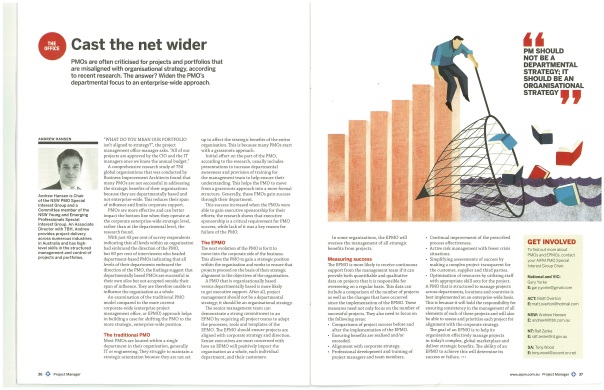Much has been written about how best to establish a project management office (PMO). There are many elements to take into account, and this article seeks only to provide what we believe are a few “pointers” to consider.
For purposes of this article, we’ll assume that we are in a situation in which we (or you) work for an organisation with no existing type of PMO. It is important to fully understand the ‘driver’ for introducing a ‘PMO’ of any type.
See How to create a clear project plan.
When we say “of any type”, we mean — what type of PMO are we talking about? What does the “P” stand for in this abbreviation for a Management Office? A PMO can serve to control governance for projects, it may oversee a program of work, or it can operate at an enterprise level and therefore be more strategic. In one way or another, all PMOs are ‘governing bodies’. The questions you need to ask are:
“Do the key people in my organisation agree that a PMO is required, agree on the authority of the PMO (and have I clearly articulated the benefits of introducing one)?”
“Are our processes mature enough for us to capture the value of a PMO and to make the long-term commitment required for success?”
Before embarking on a plan to introduce a PMO, you may have discussions with key stakeholders, perhaps conduct a survey, and/or hire an organisational development consultant to conduct an independent assessment. The bottom line is similar to the way a talent agent spots a future star performer or a coach, the next top-rated athlete.
In addition to talent and ability, the organisation needs to have the drive to introduce the type of PMO that you feel will provide the greatest benefit. If, after reviewing the proposal, you feel that key stakeholder support and/or your capacity to introduce a PMO is not yet in place, it is better to stop and continue to focus on managing programs and projects well.
Don’t see the inability to implement a PMO as a failure of any kind — different organisations have different needs. On the contrary; one sign of a good leader is recognising when an organisation is ready or not ready to change in some way. Also remember that although many organisations have some form of strong governance in place, they do not consider or call it a PMO (it is fair to say that the term PMO is, for the most part, confined to IT organisations or departments).
Taking all of this into account, if you’re certain that introducing a PMO into your organisation is a worthy objective (and have the right stakeholder backing), the rest of this article may be of interest for you.
If you do an online search on PMO’s and project governance, it will return thousands of hits. There is a large amount of extremely useful advice available, both free and from specialists who charge for their time. In writing this article, it is not our intention to repeat information already available; rather, we are providing some insight into what’s worked and not worked for us when initiating and managing PMOs.
Step 1: Prepare yourself — The road ahead will not be easy. The individual charged with leading the introduction of the PMO will need to be well-rested, and able to focus a large percentage, if not all, of their time on the task of establishing a PMO. Let’s assume you are the person being asked to set up a PMO. Consider taking a vacation; charge your batteries for the task ahead. If you are in the middle of a course of study (such as obtaining a credential or a degree), you might want to finish before starting this task. If you are involved in volunteer activities that consume a lot of your free time, you might want to consider taking a hiatus or excusing yourself from the most time consuming responsibilities (painful as it may be). Can you do all that? — Good; you’re ready to start.
Step 2: Understanding which type of PMO you need — We mentioned earlier that there are different types of PMO. A Project Management Office usually exists to control governance on projects, and to ensure that projects are being set up with the appropriate criteria. Program Management Offices usually have a particular goal in mind, e.g., to deliver a program of work adhering to governance standards. At an enterprise level, an enterprise PMO usually represents a portfolio of work and can, in itself, be provided with reports from divisional Project Management Offices and Program Management Offices. Companies usually start with the foundation-level Project Management Office. Maturity Models are available from several organisations to help you gauge your need.
Step 3: Take an “It’s a project in itself” approach — Make alliances early and draw up a communications plan; have formal and informal conversations with key stakeholders (and know what kind of influence they all have), gather preliminary data and all information you need to completely fill out a project charter, just as you would for any other project. Ensure you have a robust business case and plan. You must have the mindset that establishing a PMO is a project in itself and your time is required to manage it. Does this include you personally taking on the full-time position as PMO manager? That would depend on whether you are the appointed person for the role.
The success criteria for justifying the PMO must be defined and understood by you and your key stakeholders. Don’t forget to communicate that the ‘end’ state for the PMO to be “part of the way we do things” will be a while away — perhaps at least a year and more likely two years to fully embed. Several factors need to be considered, but the bottom line is: What is the priority or importance of the PMO to management, and how quickly can your organisation implement the change?
Generally, organisational change transitions can either be quick and painful, or slow and relatively painless. Management buy-in is fundamental to success. Both approaches to the speed of change (fast or slow) have pros and cons; we have seen that taking an aggressive approach and ‘pushing hard’ can reap rewards, but requires a strong commitment to succeed. As the saying goes, there’s a thin line between love and hate; the same can be true about organisational change such as creating a PMO.
Step 4: Obtain buy-in for the long term — After completing your project charter, having peer-level reviews, and gaining the necessary support and alliances to make it a success, step back and take a good look at the approach and the desired end result. Depending on the size of your organisation, is your launch strategy acceptable? For example, are you proposing a new level of central control or a phased approach of having several ‘federated’ PMOs that manage their business to a common, accepted level of process? The latter would involve having a few simple, comparable and easily cumulative metrics versus trying to get everyone to follow the required changes for a centralised PMO.
Whatever your plan, be sure that the C-level executives agree to it for the long term. We suggest that you are conservative in your proposed results and set realistic goals, timelines, savings, productivity improvements, etc. The implementation of a PMO is often a major change effort, so it is best to have realistic expectations and support your assumptions with a calculated degree of confidence.
Articles on PMO’s often refer to the establishment of short-term and long-term goals. This can be a great strategy as long as the focus on the short-term results does not obscure the long-term results and change. If you take this approach, be certain that you clearly communicate both expected outcomes, results and the timeframe of all milestones along the way. Remember, the long-term results are the measure of your real success.
Step 5: Achieve, document, and communicate early wins — Look for, achieve and communicate ‘early wins’ as the PMO starts to make changes, even if they’re miniscule. Any positive changes in project execution or unsolicited positive feedback should be documented and sent as a ‘news flash’ to your team, management, and stakeholders. Don’t oversell; you will also have negatives that, in fairness, you’ll also need to communicate (have no doubt; if you don’t, someone else will) so that progress as a whole can be accessed.
Step 6: Stay positive through the ‘lull’ period — As with most projects and project teams, there may be initial enthusiasm but, as the ‘newness’ wears off and the work really starts to make an impact, there can be a drop in morale and ‘esprit de corps’. If you spot this lull, keep up the positive vibe. Make no mistake; setting up a PMO can be a big challenge to implement. The period most likely to require attention is during the lull period between the times during which you’ve completed, documented, and communicated your early wins or short-term goals, and the commencement of achieving the long-term objectives for your PMO. It is then that the changes proposed, approved, and implemented will make a strategic impact on the prior routines, and your customers (including the PM’s in the PMO and those they support) will start to react to the impact of the change agents.
Step 7: Know when to declare ‘success’ — Okay. Hopefully, after all your efforts and successes, the PMO is, for all intents and purposes, working. You have documented processes, common metrics, basic standards, common tools, a central repository, training packages, and are seeing visible improvements, such as greater accuracy of project estimates, there’s more predictability about project schedules and budget outcomes, project phases are being reviewed as part of governance, lessons are being shared and learnt, and your manager and stakeholders are pleased with the progress.
As they say, it’s an 80/20 rule and you’re 80 per cent there now. Keep in mind that the final 20 per cent of the work to optimise your PMO could take as much effort as the first 80 per cent. This is the time that you need to look at benefits versus value and the effort to achieve that final 20 per cent. Is it worth it to continue driving to the final improvements, or is it time to declare success and let quality reach its ideal level over time?
This is not an easy decision: it’s time to scan the environment in which the PMO operates, make a decision and provide recommendations for the next steps. By the way, there’s nothing wrong with taking a six-month pause, monitoring the results, and then proposing a ‘phase 2’ of PMO activities. Assuming that you are successful and always focus on your key stakeholders, the backing and momentum to continue building the PMO will happen. Be very aware of any organisational changes that may take place — it is a fact of life in modern organisations is that change is part and parcel of the future.
It is important to ensure that quality of service is maintained, and that the driving forces of “how you do things” are being shared across the teams that use and function within the PMO. If the PMO has become its own department and is visibly providing value, you should be set. If it is still ad-hoc and ‘pieced together’ by evangelists, then perhaps the best decision is to keep managing it as a project until you see that the embedment has occurred.
In conclusion, in any type of organisation or company, there are many ways to implement a successful PMO. Different organisations have different needs.
Whichever way you choose, treat the creation of a PMO as a project in itself and manage it accordingly;
-Decide what type of PMO you need (if indeed you choose to call it a PMO);
-Justify it with a proper business case and plan;
-Think about the long-term objective and short-term goals to celebrate along the way;
-Recognise when to decide if the PMO is ‘as good as it gets’ and is part and parcel of the operations;
-Finally, remember that if the implementation of a PMO is not progressing as planned, maybe it is not the right thing for your
organization (at least, at that specific point in time).
-33.866971
151.205136




